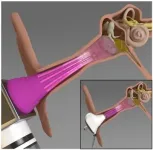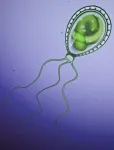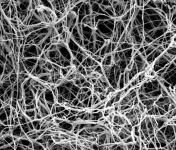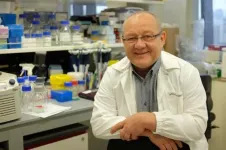Researchers develop a new technique to treat middle ear infections
2021-06-28
(Press-News.org) Middle ear infections, also known as otitis media, affect more than 80% of the children in the U.S. In a new study, researchers have designed a miniaturized 3D-printed device to inactivate Pseudomonas aeruginosa, a common bacterium that causes the infection.
The device--a microplasma jet array--generates plasma, which is composed of charged particles and reactive molecules that have been previously shown to inactivate various pathogens. "This is the first time anyone has tried treating middle ear infections using plasma technology," said Jungeun Won, a graduate student in the Boppart lab. "Usually, the treatment involves using antibiotics or surgical intervention."
The problem with using antibiotics is two-fold. First, antibiotics are ineffective in more than 30% of the patients with acute infections. Second, their use can lead to increased antibiotic resistance because the bacteria form biofilms--aggregates that attach to the surface of the ear.
"Biofilms are very dense, making it difficult for the antibiotics to penetrate," said Helen Nguyen (IGOH), an Ivan Racheff Professor in Civil and Environmental Engineering. "Our idea was that if we could disrupt the structure of the biofilm, we could increase the penetration of the antibiotics."
The researchers tested the microplasma jet array by building a model of the middle ear. They used an excised rat eardrum and tested the antimicrobial effects of the microplasma on the bacteria that were located behind the eardrum.
"We used different duration times for the treatment and found that 15 minutes and longer was effective in inactivating the bacteria," Won said. "We also monitored the tissue to see if we had created any holes or ruptures, but we didn't find any obvious physical damage."
"We think that the microplasma disrupts the biofilm by disturbing the bacterial cell membrane," Nguyen said. "So far, we only have indirect measurements supporting our idea, but we will look into it in the future."
Although the thickness of the rat eardrum is 30% lower than that of a human, which is about the width of a hair strand, the results suggest that the microplasma treatment could be used to treat middle ear infections in humans.
"Middle ear infections and the over-prescription of antibiotics to treat these are major clinical challenges that are in need of new treatment technologies and solutions," said Stephen Boppart, Grainger Distinguished Chair in Engineering, who is also a medical doctor.
The researchers are now designing a smaller, earbud-shaped jet array for treatments that will allow longer exposure times. They will also test the devices on animal models using biofilms of the other bacteria that cause middle ear infections, including, but not limited to, Haemophilus influenzae, Streptococcus pneumoniae, and Moraxella catarrhalis, to test whether the treatment is also effective with these bacteria. Additionally, the researchers will closely monitor the tissues of the middle ear to ensure that there is no structural and functional tissue damage from the plasma technology.
INFORMATION:
The study was carried out in collaboration with the labs of J. Gary Eden, Intel Alumni Endowed Chair Emeritus in Electrical and Computer Engineering, and Stephen Boppart, a Grainger Distinguished Chair in Engineering, with appointments in the Departments of Electrical and Computer Engineering, and Bioengineering.
The study "Inactivation and sensitization of Pseudomonas aeruginosa by microplasma jet array for treating otitis media" was published in npj Biofilms and Microbiomes and can be found at 10.1038/s41522-021-00219-2. The work was funded by the National Science Foundation, the U.S. Air Force Office of Scientific Research, and the National Institutes of Health.
[Attachments] See images for this press release:

ELSE PRESS RELEASES FROM THIS DATE:
2021-06-28
HUNTINGTON, W.Va. - According to researchers at Marshall University, a maternal diet rich in Omega-3 fatty acids protects from breast cancer development in offspring. In a new study recently published by Frontiers in Cell and Developmental Biology, researchers noted a significant difference in mice from mothers that were fed a diet rich in canola oil, compared with mothers fed a diet rich in corn oil. A maternal Omega 3-rich diet affected genome-wide epigenetic landscape changes in offspring and potentially modulated gene expression patterns.
Dr. Ata Abbas, a former postdoctoral research fellow in Marshall's Department of Biological Sciences, headed a research team under the leadership ...
2021-06-28
New Brunswick, N.J. (June 28, 2021) - A Rutgers-led study sheds new light on the evolution of photosynthesis in plants and algae, which could help to improve crop production.
The paper appears in the journal New Phytologist.
The scientists reviewed research on the photosynthetic amoeba Paulinella, which is a model to explore a fundamental question about eukaryote evolution: why was there a single origin of algae and plants? That is, why did photosynthesis by primary plastid endosymbiosis not originate multiple times in the tree of life?
Photosynthesis is the process by which plants and other organisms use sunlight to synthesize ...
2021-06-28
A first-of-its-kind longitudinal study of infant curiosity found that months-old babies most captivated by magic tricks became the most curious toddlers, suggesting a pre-verbal baby's level of interest in surprising aspects of the world remains constant over time and could predict their future cognitive ability.
"Something about a baby's curiosity about magic tricks is predicting how curious they become as preschoolers," said Lisa Feigenson, co-director of the Johns Hopkins University Laboratory for Child Development. "What the data suggest is that some three-year-olds have a leg up or seem particularly well positioned to learn a lot about the world."
The findings appear today in Proceedings of the National Academy of Sciences.
Until this study, little was known about curiosity ...
2021-06-28
New Brunswick, N.J. (June 28, 2021) - COVID-19's socio-economic effects will likely cause another severe production crisis in the coffee industry, according to a Rutgers University-led study.
The study, which appears in the journal Proceedings of the National Academy of Sciences, included researchers from the University of Arizona, University of Hawaii at Hilo, CIRAD, Santa Clara University, Purdue University West Lafayette and University of Exeter.
"Any major impacts in the global coffee industry will have serious implications for millions of people across the globe, including the coffee retail ...
2021-06-28
An Australian mammal thought to have been wiped out over 150 years ago can now be crossed off our list of extinct animals, following a new study.
Researchers compared DNA samples fromeight extinct Australian rodents, as well as 42 of their living relatives, to look at the decline of native species since the arrival of Europeans in Australia.
The study showed the extinctGould's mouse was indistinguishable from the Shark Bay mouse, still found on several small islands off the coast of Western Australia.
According to lead author Dr Emily Roycroft ...
2021-06-28
Scientists have made a breakthrough in understanding the process that leads to a blood clot forming in the lungs - a condition that kills more than two thousand people in the UK each year.
The clot forms a pulmonary embolism or blockage, cutting off blood flow to major blood vessels in the lungs.
In many cases, the blockage is caused by fragments that have broken away from a blood clot elsewhere in the body, such as a deep vein thrombosis in one of the legs. The fragments are transported to the lungs via the blood stream.
In a paper published today (28 June) in the scientific ...
2021-06-28
The billions of microbes living in your gut could play a key role in supporting the formation of new nerve cells in the adult brain, with the potential to possibly prevent memory loss in old age and help to repair and renew nerve cells after injury, an international research team spanning Singapore, UK, Australia, Canada, US, and Sweden has discovered.
The international investigating team led by Principal Investigator Professor Sven Pettersson, National Neuroscience Institute of Singapore, and Visiting Professor at Lee Kong Chian School of Medicine, Nanyang Technological University, Singapore (NTU Singapore), and Sunway University, Malaysia, found that gut microbes that metabolise tryptophan - an essential amino acid - secrete small molecules called ...
2021-06-28
Researchers from Tallinn University of Technology, Grete Raba, Signe Adamberg, and Kaarel Adamberg showed that an acidic environment enhances the production of butyric acid from apple pectin by faecal bacterial consortia - microbiota. Pectin is a dietary fibre abundant in apples, berries, fruits, and vegetables. Pectin is used in jellies and desserts. As human digestive enzymes are not able to degrade pectin, it is metabolized by the microbes of the large intestine. The main conclusions of the research, published in FEMS Microbiology Letters, was the importance of environmental acidity (pH) on the composition and metabolism of colon bacteria. The colonic pH is, however, strongly related to one's diet.
Fibre-rich diets that contain plenty of whole-grain ...
2021-06-28
A connective tissue protein known to support the framework of organs also encourages immune responses that fight bacterial infections, while restraining responses that can be deadly in the condition called sepsis, a new study finds.
Led by researchers from NYU Grossman School of Medicine, the work revolves around the extracellular matrix (ECM) of connective tissues, once thought of as an inert framework that shapes bodily compartments, but increasingly recognized as a signaling partner with nearby cells in normal function, and a contributor to disease when signals go awry. Among the key players in the ECM are fibroblasts, the cells that make tough structural matrix proteins ...
2021-06-28
WASHINGTON, June 28, 2021 -- Ancient Rome's emperors did some pretty bizarre stuff -- bursting into uncontrollable fits of laughter, appointing a horse as a priest, dressing in animal skins and attacking people ... the list goes on. Why were they acting that way? Well, it might have been lead poisoning. In this week's episode, we unwrap the possibility that lead caused the Roman Empire's collapse: https://youtu.be/4k7CvSiomlA.
INFORMATION:
Reactions is a video series produced by the American Chemical Society and PBS Digital Studios. Subscribe to Reactions at http://bit.ly/ACSReactions and follow us on Twitter @ACSReactions.
The American Chemical Society (ACS) is ...
LAST 30 PRESS RELEASES:
[Press-News.org] Researchers develop a new technique to treat middle ear infections







